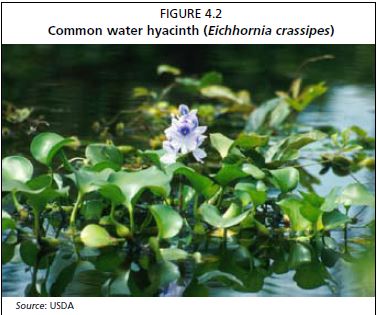4.2. Characteristics
4.2.1 Importance
Water hyacinths are found in most of the tropical and subtropical countries of the world. According to Mitchell
Figure 4.2
Common water hyacinth (Eichhornia crassipes) Source: USDA

(1976), the water hyacinth is indigenous to South America, particularly to the Amazonian basin. It started its worldwide journey as an ornamental plant when first introduced into the USA in 1884 (Penfound and East, 1948 cited by Edwards, 1980). It reached Australia in 1895, India in 1902, Malaysia in 1910, Zimbabwe in 1937 and the Republic of the Congo in 1952.
4.2.2 Environmental requirements
According to Wilson et al. (2001) there are five main factors limiting the growth rate and carrying capacity of water hyacinth: salinity, temperature, nutrients, disturbance and natural enemies.
Water hyacinths seem unable to survive salinities above 2 ppt. Olivares and Colonnello (2000) reported that water hyacinth survives salinities of 1.3-1.9 ppt in the Orinoco (South America) and Kola (1988) reported that the plant grew well at salinities below 1 ppt.
Low temperatures stop the plant establishing in temperate areas and prevent it from reaching high levels in the sub-tropics. Knipling, West and Haller (1970) proposed a parabolic relationship between temperature and growth rate, with growth tailing off quickly after the optimum of 30 ?C. Imaoka and Teranishi (1988) proposed that the intrinsic growth rate, r, increases exponentially with ambient temperatures in the range 14-29 ?C, growth ceasing below 13 ?C. Frost is a major cause of leaf mortality in temperate regions. Applying mathematical modelling, using existing data, Wilson, Holst and Rees (2005) examined the role of two important environmental factors, temperature and nutrient level, on the growth of water hyacinths. Their model predicted a linear reduction in specific growth rate with density. These authors set the minimum (Qmin), optimum (Qopt) and maximum (Qmax) temperatures for water hyacinth as 8, 30 and 40 ?C, respectively. The growth of water hyacinths is affected by low air humidity, ranging from 15-40 percent relative humidity (Freidel and Bashir, 1979).
The levels of available nitrogen and phosphorous are the most important factors limiting growth (Wilson et al. 2001). The half-saturation co-efficients for water hyacinths grown under constant conditions have been found to be from 0.05-1 mg/l for total nitrogen and from 0.02-0.1 mg/l for phosphates. Growth quickly tails off below the lower limits. Wilson, Holst and Rees (2005) suggested that nitrogen is limiting if total nitrogen concentration is less than seven times that of the phosphorus concentration. Water hyacinths show logistic growth. The model assumed that plants grow in the absence of interspecific competition. In fact, the plant soften grow in areas previously free of aquatic vegetation.
Flooding can break up large mats of water hyacinth and leave plants stranded on land (Wilson et al. 2001). Wave action may limit growth by directly damaging plants and by forcing the weed to maintain aerenchymatous tissue.